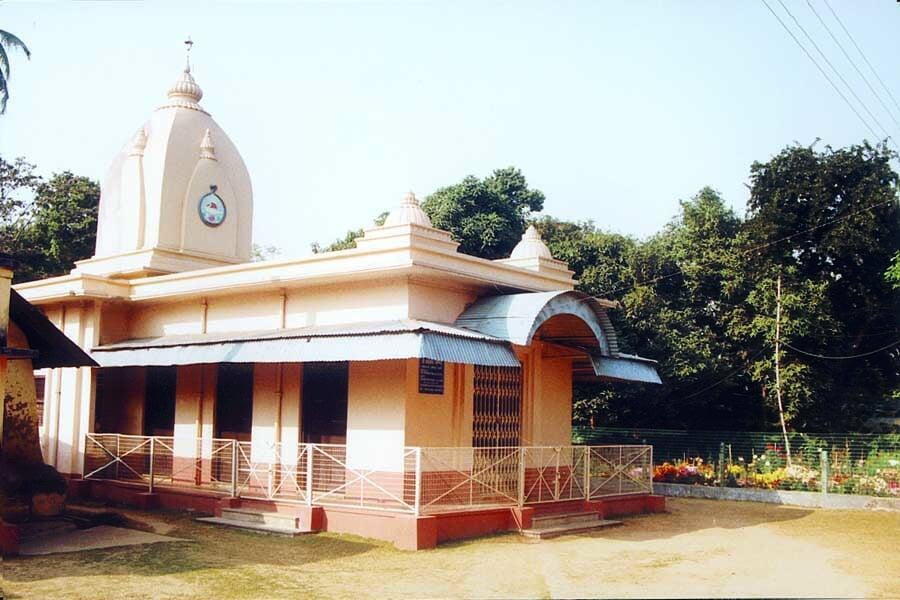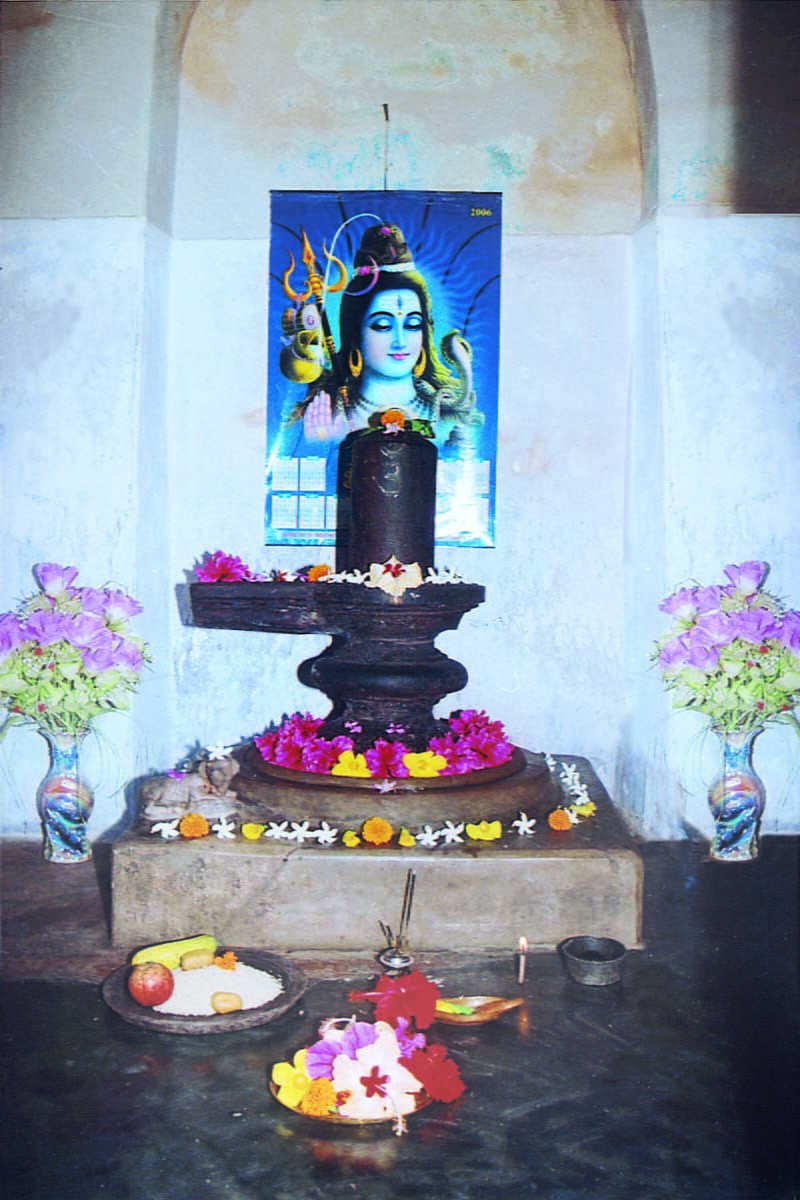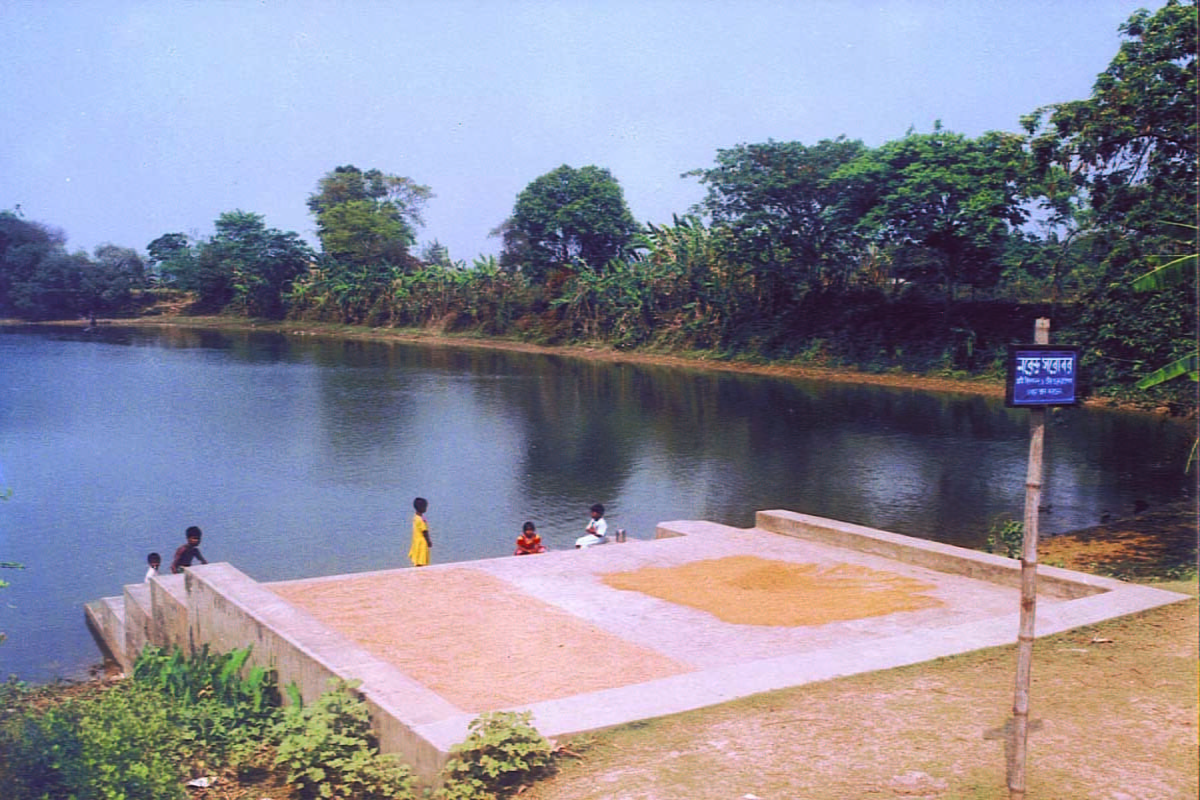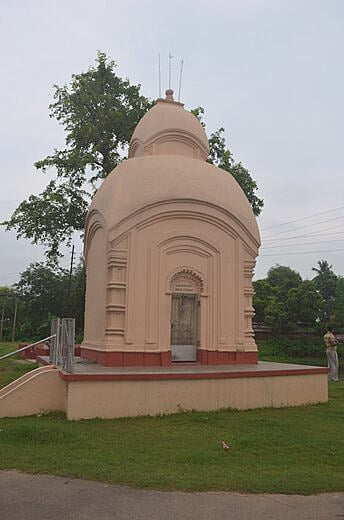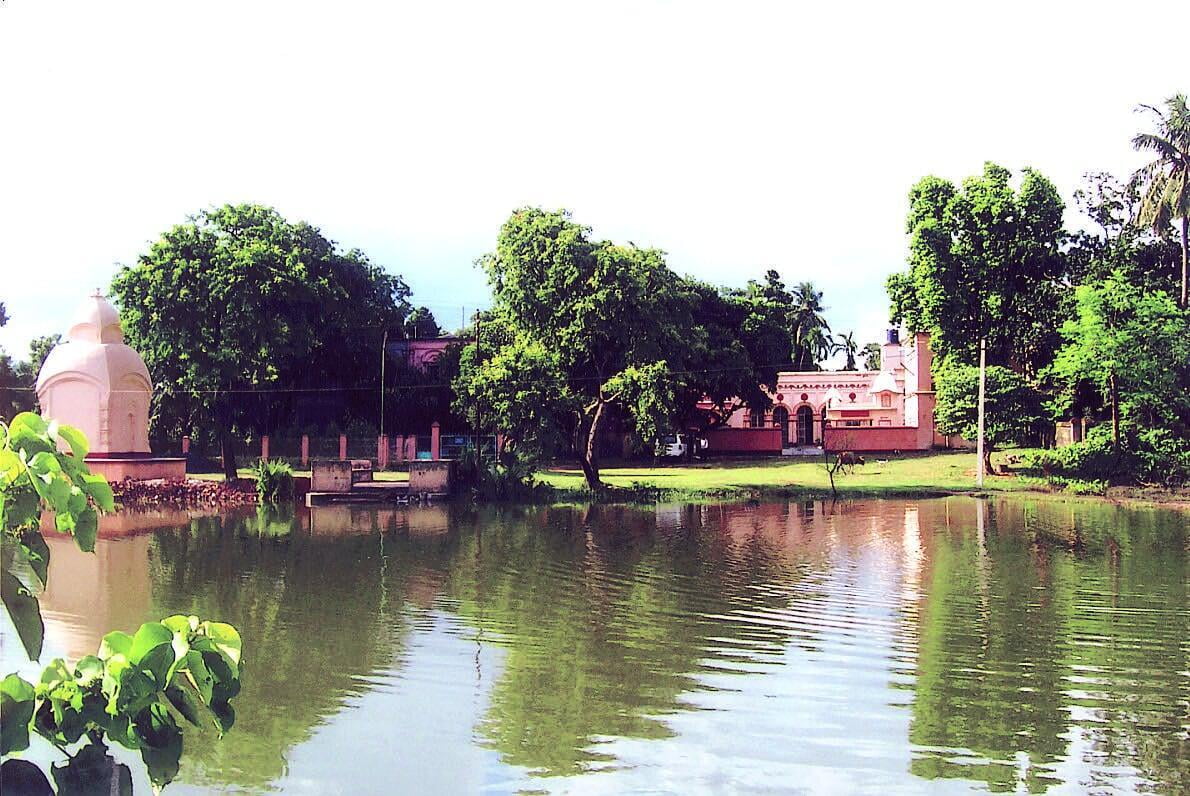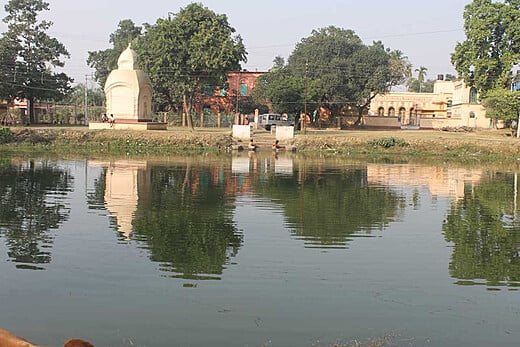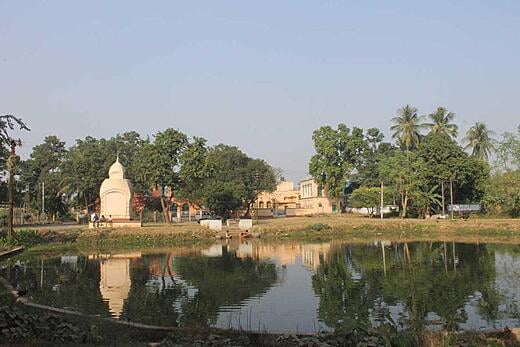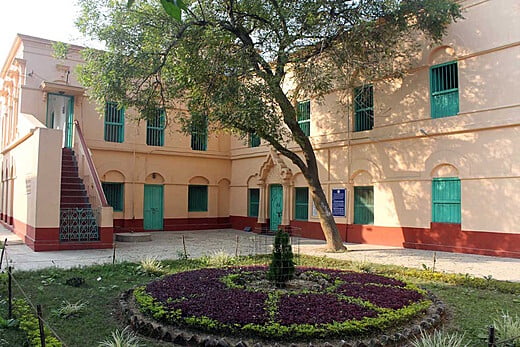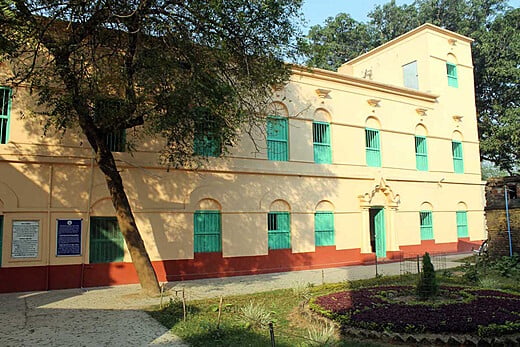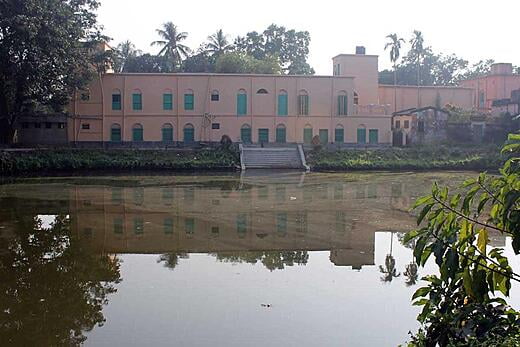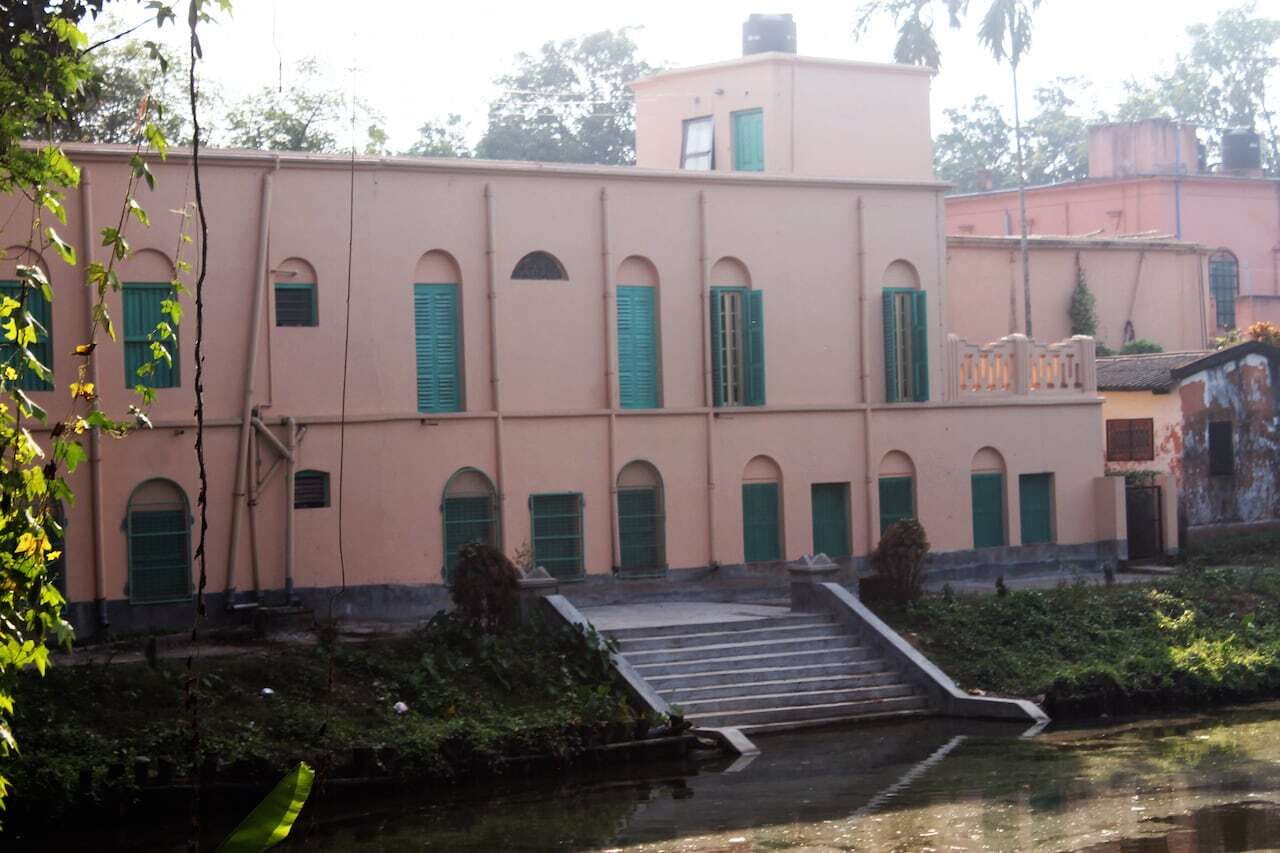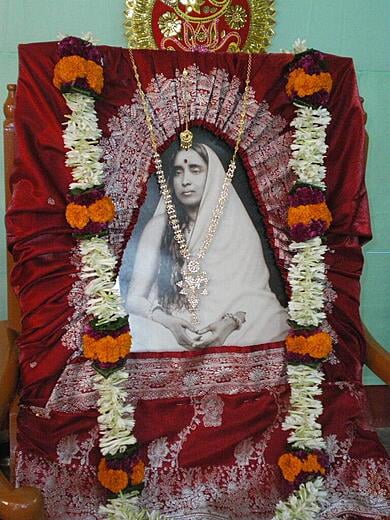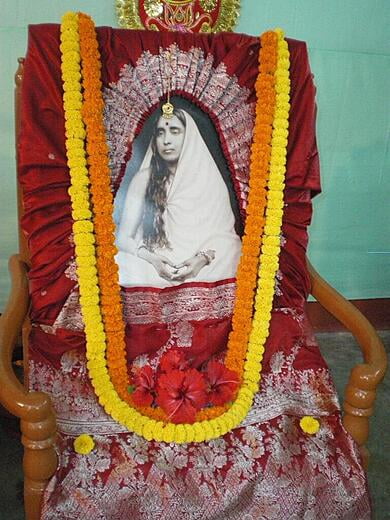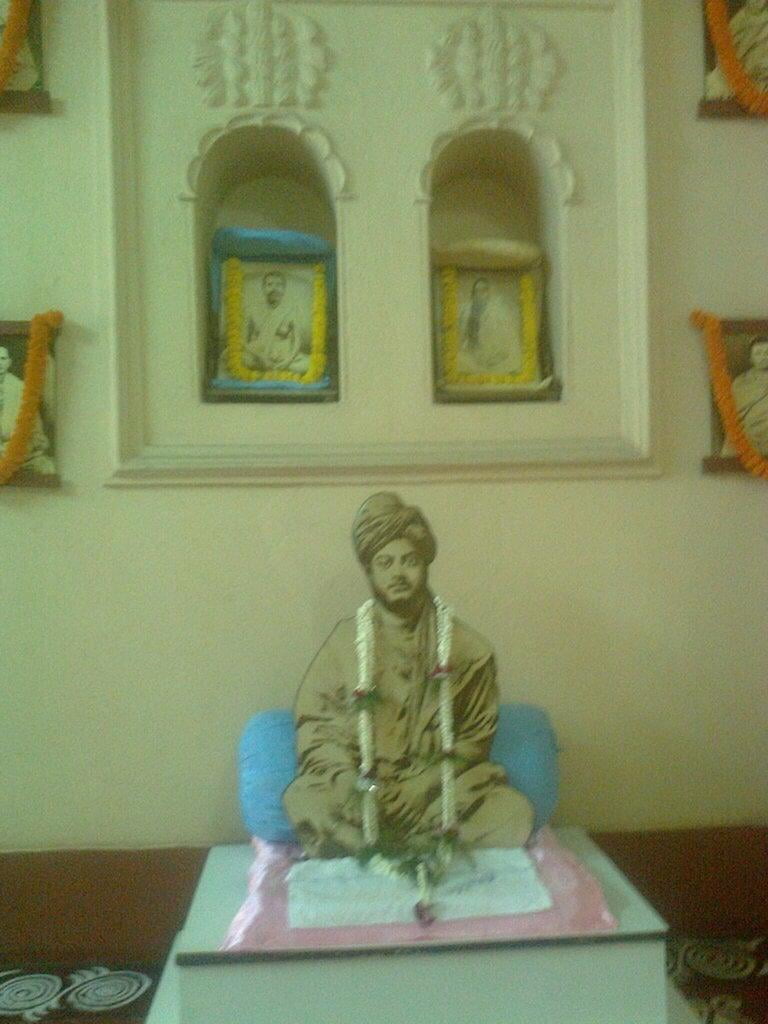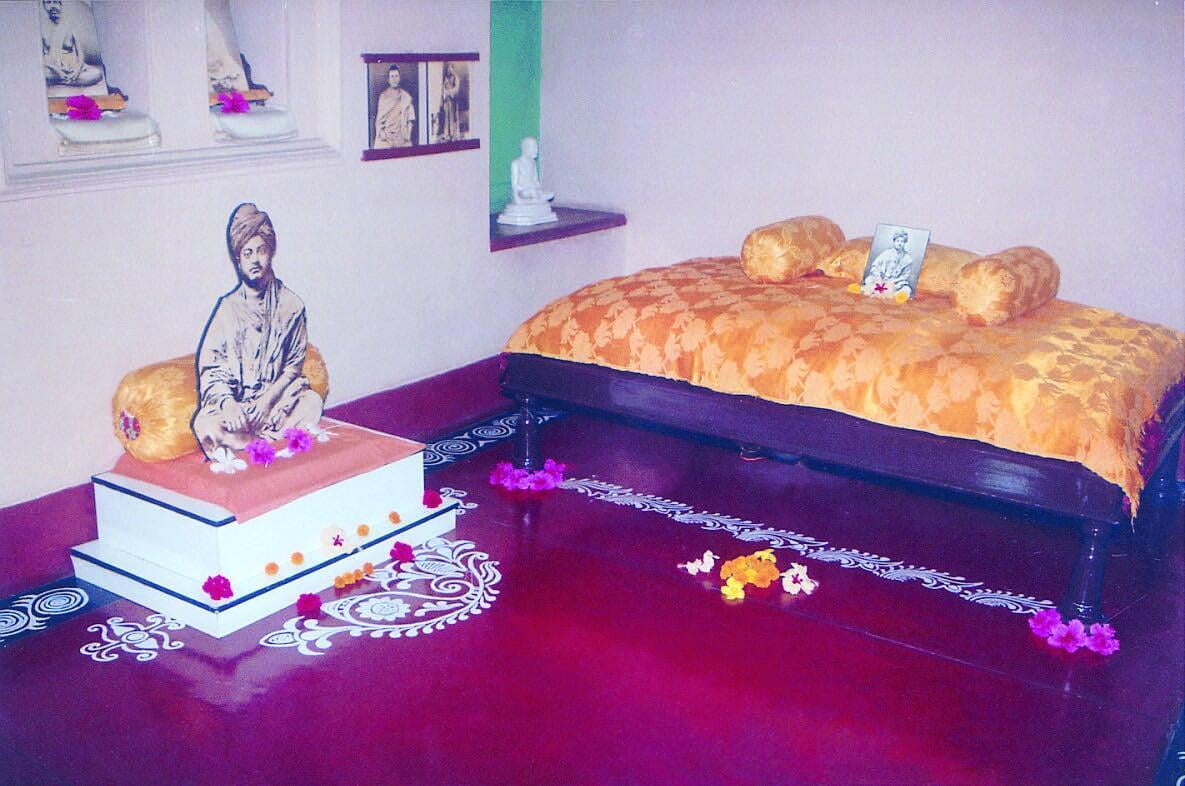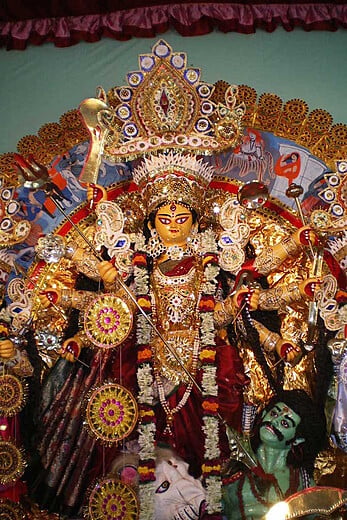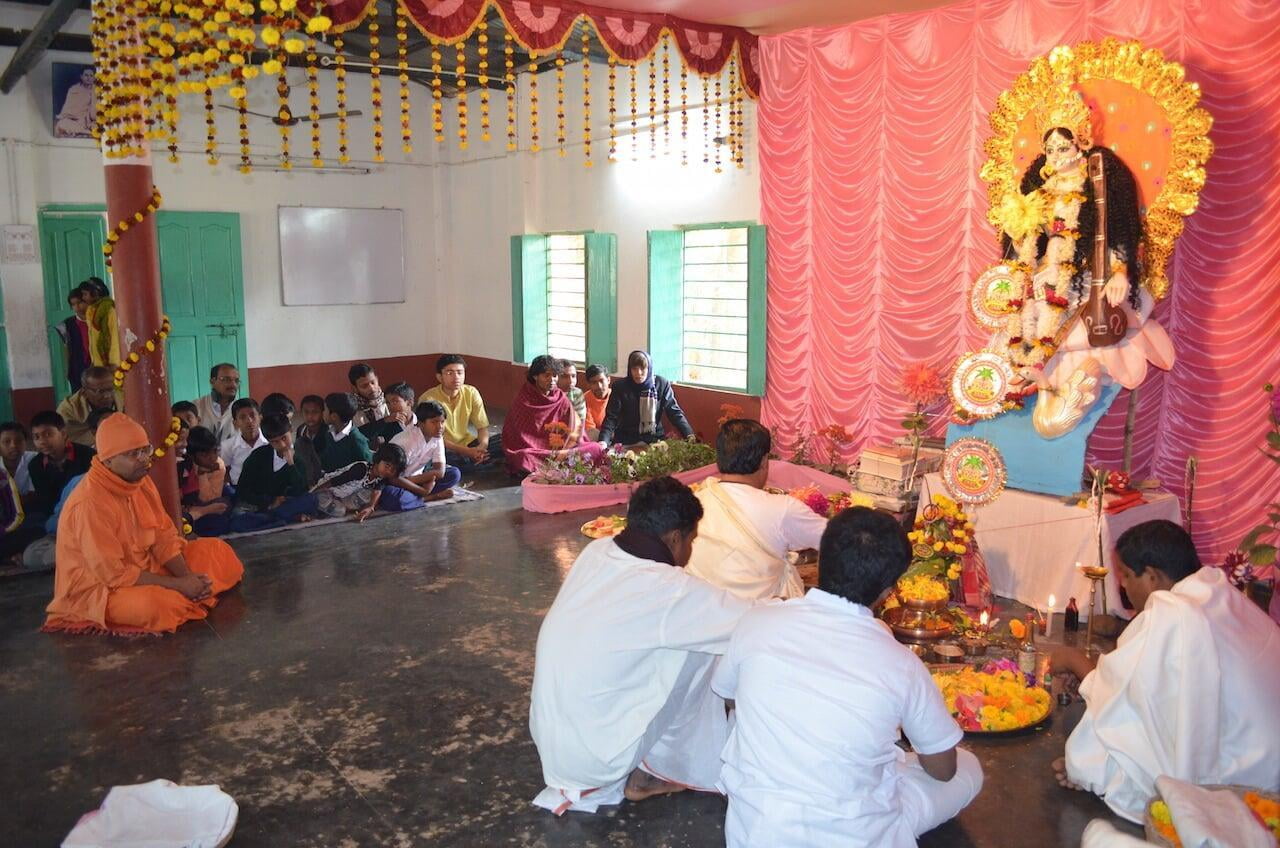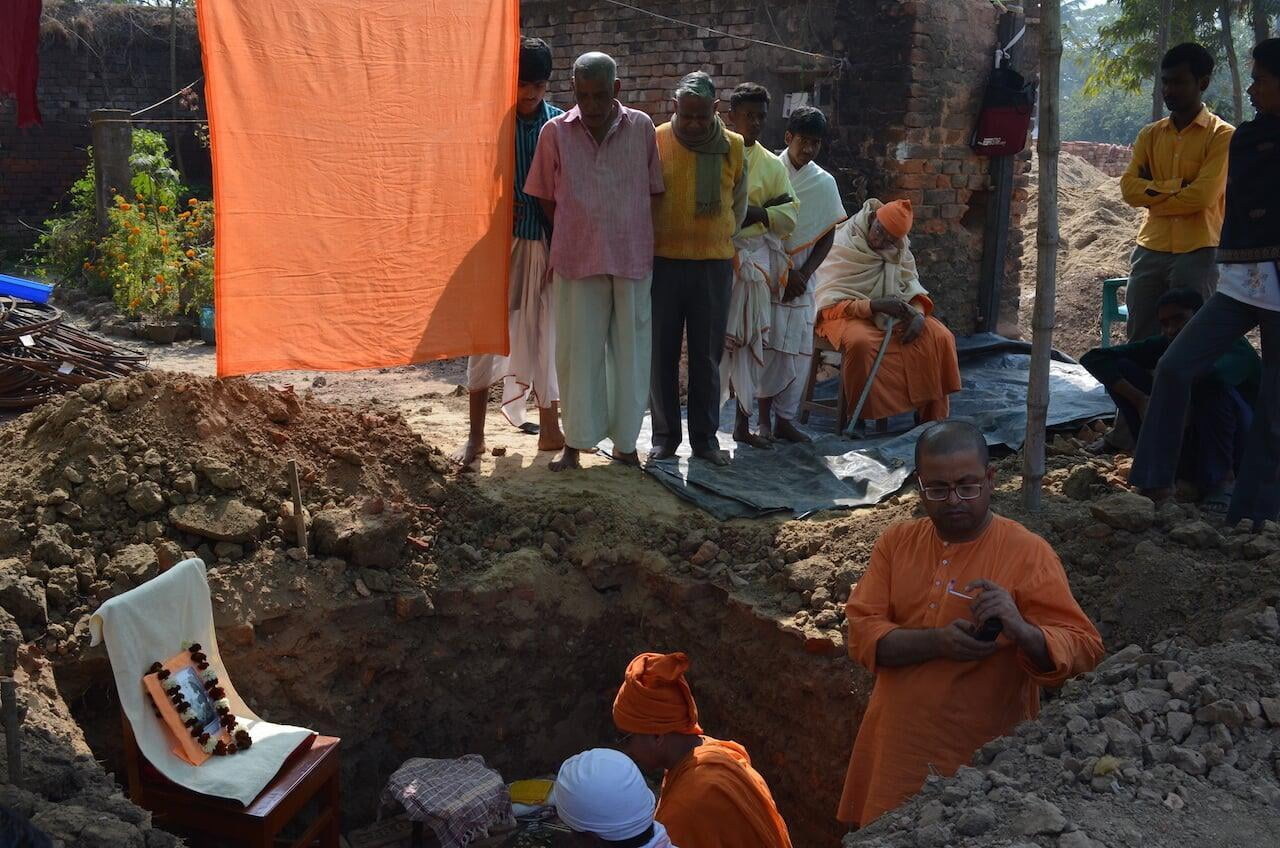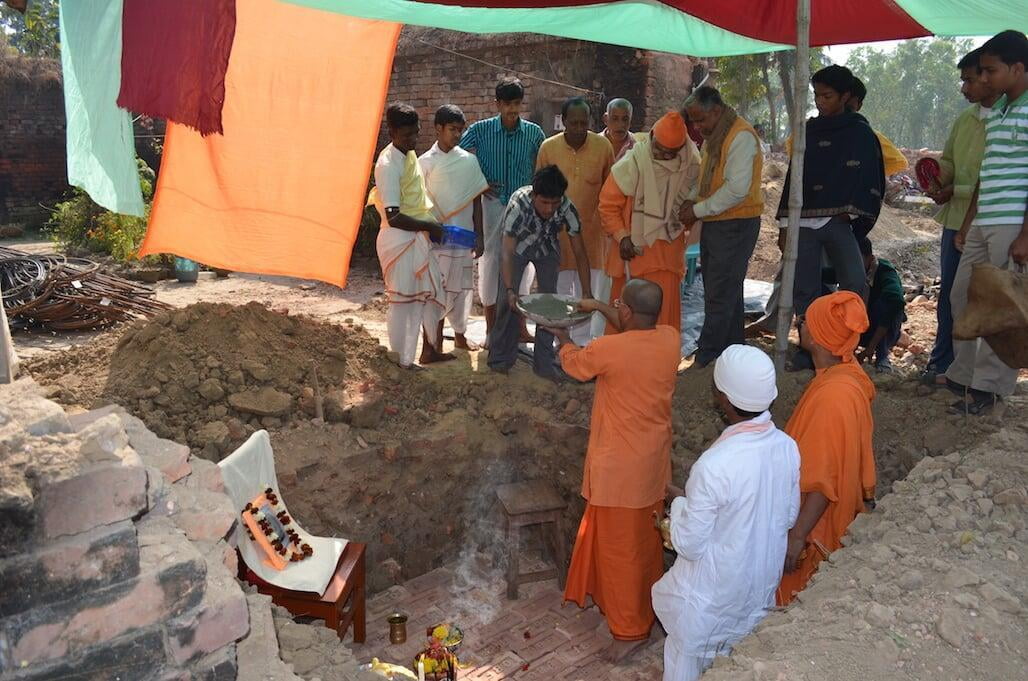Visit Antpur – A Pilgrimage
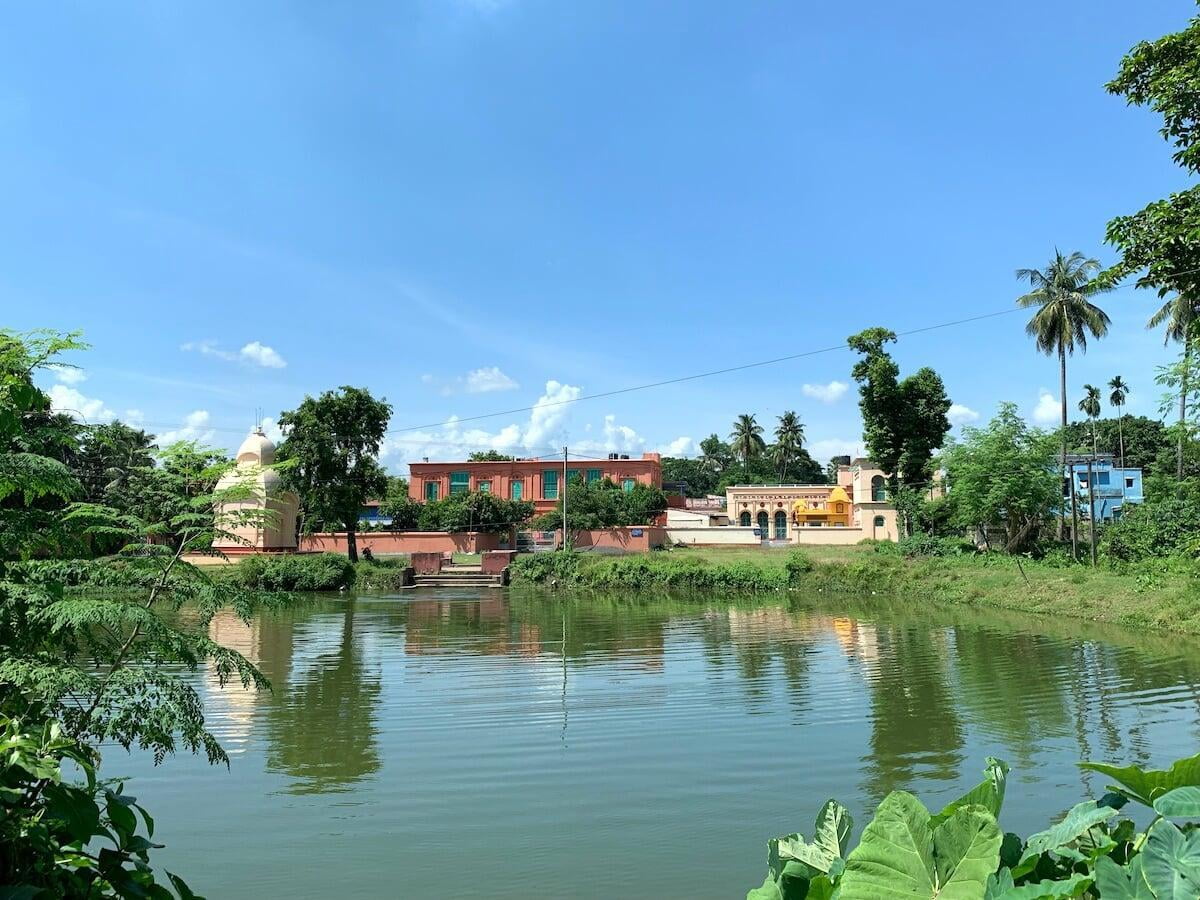
1) The Temple Of Shri Ramakrishna At The Birth Place Of Swami Premananda
One enters through the “Bagh Phatak” (Tiger Gate) to the right of Premananda road and walks towards the right along the bank of the pond. After a while one reaches the temple. The journey begins from the ‘Shri Ramakrishna’ temple. The foundation of the temple was laid by Swami Vireswaranandaji, the then General Secretary, Ramakrishna Math and Ramakrishna Mission on 16th June, 1961. On the 3rd of December, 1965, the temple was consecrated with pomp by Swami Nirvananandaji, the then Vice President. The sanctum chamber stands right on the exact birthplace of Swami Premanandaji. Before the sanctum chamber was built, there stood a pavilion of Maharaj-ji’s maternal house. He was born there. On a tastefully decorated wooden throne on the pulpit of the temple, are placed the photographs of Bhagavan Shri Ramakrishna, the Universal Mother Saradadevi, the Acharya (Preceptor) of this age Swami Vivekananda and Swami Premananda.
They are worshipped daily with due solemnity. The adjacent chamber (the Natamandira – the foyer) is gloriously lit up by the photographs of the intimate associates of the Lord. The peace and serenity prevailing there is incomparable. One’s heart finds solace if one sits for some time at the village temple of the Lord away from the urban hustle and bustle. The gentle breeze all around soothes one’s body and soul.
2) Five Shiva Temples
Let us now proceed keeping the pond to our left. The temples in the front, surrounded by a boundary wall were all founded by Baburam’s maternal family. As we turn right we are right in front of the ‘Gangadhar’ Shiva temple. Besides this there are four other Shiva temples here, named ‘Vaneshwara’, ‘Phuleshwara’, ‘Jaleshwara’ and ‘Rameshwara’. The temple of Rameshwara Shiva is the largest. These temples were built between 1751 A.D. and 1773 A.D.
3) The spot sanctified by the holy feet of The Thakur
Now we proceed a few steps and look at our right we find a memorial column. Behind this column stood the house of Kalu and Bhulu.
Through the passage of time this house has now been in ruins. The landlord of this village Shri Ramprasad Mitra lived in a rented house in Jhamapukur in Calcutta. Around 1853 A.D. Young Gadadhar (later Shri Ramakrishna) lived in the ‘Tole’ (small coaching centre) of his elder brother Ramkumar and used to go frequently to the house of Shri Mitra. Gadadhar became very friendly with the two sons of Shri Mitra, namely Shri Kalicharan (Kalu) and Shri Umacharan (Bhulu). They were of the same age as ‘Shri Ramakrishna’. Through that contact Ramakrishna was probably invited in 1854 A.D. to the Durga Puja celebrations at their village house and lived there for a few days. He was then nineteen years old. After staying here at Antpur for a few days, Ramakrishna left for Kamarpukur. To keep alive the memory of Shri Ramakrishna’s holy arrival, the successors of the Mitra family unconditionally donated this plot of land containing the holy site to Antpur Ramakrishna Math. Now a neatly decorated park stands here.
The village next to it is named Tada. In those days this village used to be known as Tada-Antpur. When Baburam (later Swami Premananda) met Shri Ramakrishna at Dakshineshwar for the first time and Thakur came to know that Baburam’s residence was at Tada-Antpur he said “Oh! then I had been to your village once”. A piquant dialogue regarding Thakur’s visit to Antpur may be recounted here. Coming out of the Kali temple at Dakshineshwar Thakur was in high ecstasy and walking in unsteady footsteps, like a drunk, came and sat on the small bed in his room. Gradually he became normal and asked about the identity of the newly-arrived devotee. Getting to learn the identity from the words of Ramdayal, Thakur said ”Oh! Balaram’s relative; then he is also our relative. Well, nice to know that. Which village is your residence? ”
Baburam – Sir, it is Tada-Antpur
Ramakrishna—Really, then I have been to your village once. Isn’t the residence of Kalu-Bhulu of Jhamapukur in your village?
Baburam—Yes; but how do you happen to know them?
Ramakrishna—Well they are the sons of Ramaprasad Mitra. When I lived at Jhamapukur I used to go to the houses of Digambar Mitra and Ramprasad Mitra every now and then.
Wherever God goes and engages in playful activities, the place becomes a pilgrimage. It is thus that Kasi and Kanchi, Puri and Nabadwip, Dwarka and Rameshwar have become venerable pilgrimages. Likewise Antpur has also become respondent and bright like a pilgrimage.
4) The ancient Chandi Mandapa
Let’s now go through the small gate on the western side. On your right you can see a hexagonal structure which is the Chandi Mandapa nearly three hundred years old. From Bengali Calendar year 1290 Durga puja and Chandipuja are being observed in this structure every year. As you can see the entire structure is wooden, said to be made of jackfruit wood. Its design resembles an inverted boat, a popular style in those days. If you look carefully you will see that Goddess Durga, Kali, Jagatdhatri and many other sculptures are there. All these sculptural ornamentations are the hand work of Bengali artisans. It is said that two such structures were erected at a cost of Rs. one lakh. One of these two was destroyed in a later day storm. For non-availability of quality artisans another structure like the destroyed one could not be erected in spite of best efforts. The adjacent Natamandira (foyer) with two iron posts was constructed much later.
5) Bakultala
Coming out the ‘Bakul’ tree that you see is said to be of those times, more than two hundred years old. Its base is cemented now. The breeze is heavy with the scent of Bakul flower and the ambience is pleasant being cool and shady.
6) The temple of Shri Radha-Govinda Ji
To the left of the Bakul tree basement, inside the gate, the temple that you see, is a rare specimen of excellent architecture and terracotta artwork. On the podium of the sanctum chamber, beautiful icons of Shri Radha and Shri Govinda are seated on an exquisitely crafted metal throne. Besides, the idol of Nadugopal is also present. This excellent temple was built in 1786 AD in the “Chhata” (shed with a canopy) style of those days. The sculptures and terracotta artwork panels on the temple are reminiscent of the stories of the Puranas. Besides there are other ornamental renderings; they depict the social life of those days. The artisans were mostly from the district of Bankura and some were from the district of Nadia. If you look carefully on the inside walls of the temple, you will see myriad renderings in the sculpture of the flower Lotus, design of each of these is elaborate and different. Surrounding the temple at the centre there are some buildings, which include the Zamindary office, the guest chamber of Fakirs, Monks, Mendicants and on the top of the gate there is Nahabat Khana (the Shehnai room).
7) The Dola-Mancha and the Rasa-Mancha
Coming out of the temple you will see the Dolamancha and the Rasmancha. ‘Dola’ is a spring time festival of sprinkling coloured water on one another. This is a festival centering Lord Krishna and is known as ‘Holi’ in many other parts of India, particularly northern India. Rasa is a festival of union of Shri Krishna, Shrimati Radharani and the Gopinis. On the other side is a big lake with brick-built bathing areas. The Antpur station (now extinct) once stood here. Going around you will feel that all these are sanctified by the touch of the holy feet of Thakur, Maa, Swamiji and Baburam Maharaj.
8) Swami Premanandaji’s ancestral house
Now getting out of the “Bagh Gate” (Tiger Gate) and walking for about three minutes to the east, one comes across a left turn. There stands Baburam Maharaj ji’s ancestral house. Entering the house we see the temple of Gangadhar Shiva. The Holy Mother, Swamiji and his fellow-disciples saw the Lord Shiva in this temple. During February 1922, when Swami Brahmananda came to Antpur (his last visit) he offered four three-hourly pujas to the lord. The monks participated in that worship and sang devotional songs.
It will be interesting to refer to a conversation here from a biography of Swami Brahmananda. On the Sivaratri day Ramlal dada (elder brother) was also at Antpur. When Raja Maharaj met Ramlal dada on Shivaratri morning he greeted him with a good morning and asked him if that was the Shivaratri day. When Ramlal dada confirmed, Raja Maharaj said that then they will have to be on fast. Ramlal dada agreed immediately. Raja Maharaj asked “Habisyanna is as good as fasting”. Ramlal dada replied “In a way, yes”. Raja Maharaj then said “we will then be observing Shivaratri by fasting with Habisyanna”. Dada agreed to that. Raja Maharaj then sent for Santiram (younger brother of Baburam) and told him “Look Shantiram; today is Shivaratri. We two will have Habisyanna and observe Lord’s night. You make necessary arrangements which would be similar to fasting!” Nothing much really! 15-20 varieties of vegetables to be boiled with rice. To go along to be added plenty of ‘ghee’ made of cow-milk butter. This could be a reminiscence of the fasting by Vyasadeva. A pond is there by the side of the temple. This pond is known as “Sea of colours” (Rangsagar). It is said that Raja Maharaj used to take to angling in this pond.
Shri Shri Lakshmi Narayana temple
Walking a few steps by the left of the Shiva temple we enter inside by the left-hand side gate. There on our right stands the two-storied building. The first floor is dedicated to their family deity Shri Shri Lakshmi Narayana Jiu. In this shrine one Salagrama Shila (small round stone) and a metal image of goddess Lakshmi are worshipped including the lighted lamp puja (known as arati) celebration.
Durga Mandapa
On your left you see the beautiful, traditional and ancient Durgamandapa. Here the worship of goddess Durga was being observed for many years. The same, however, came to an abrupt end because of some special reasons. Later, Matangini Devi, mother of Baburam Maharaj was asked by goddess Durga in a dream to resume the puja. Matangini entreated holy mother Saradadevi for the permission. The holy mother gladly gave permission and herself remained present when the Durga puja and Lakshmi puja were held in 1894 AD. After the pujas were over the Mother proceeded to Joyrambati. That puja is since being held regularly with due celebration and grandeur with Ramakrishna Mission at the helm.
We may refer to a letter here written in 1894 A.D. by Swamiji to Shivanandaji:
“Baburam’s mother has lost her wit at old age. Leaving aside the alive goddess Durga (Sarada devi) she has started the worship of Durga made of clay. Dada (an address to show respect to elder brother), Faith is a great treasure; Dada, on my name I swear I will show the worship of the alive Durga. Girish Ghosh is doing a lot of worship of the mother (Saradaevi); he is blessed, so is his dynasty. Dada, sometimes, when I remember the mother I say ‘Who is Rama (Ramakrishna here)’. Dada, say whatever you please whether Ramakrishna was divine or mortal, but curse him who does not have for the mother.”
Here it may be recalled that after the passing away of Shri Ramkakrishna, when Narendra and the fellow disciples went to Antpur Saradacharan was also with them. The house of Baburam was spiritually deeply charged for the few days when they were there. On one of these days Saradacharan was dressed up as Shiva and Gangadhar was dressed up as Parvati and they observed the Hara-Gauri puja.
There is indeed no end to their spirituality exhibited at Antpur.

